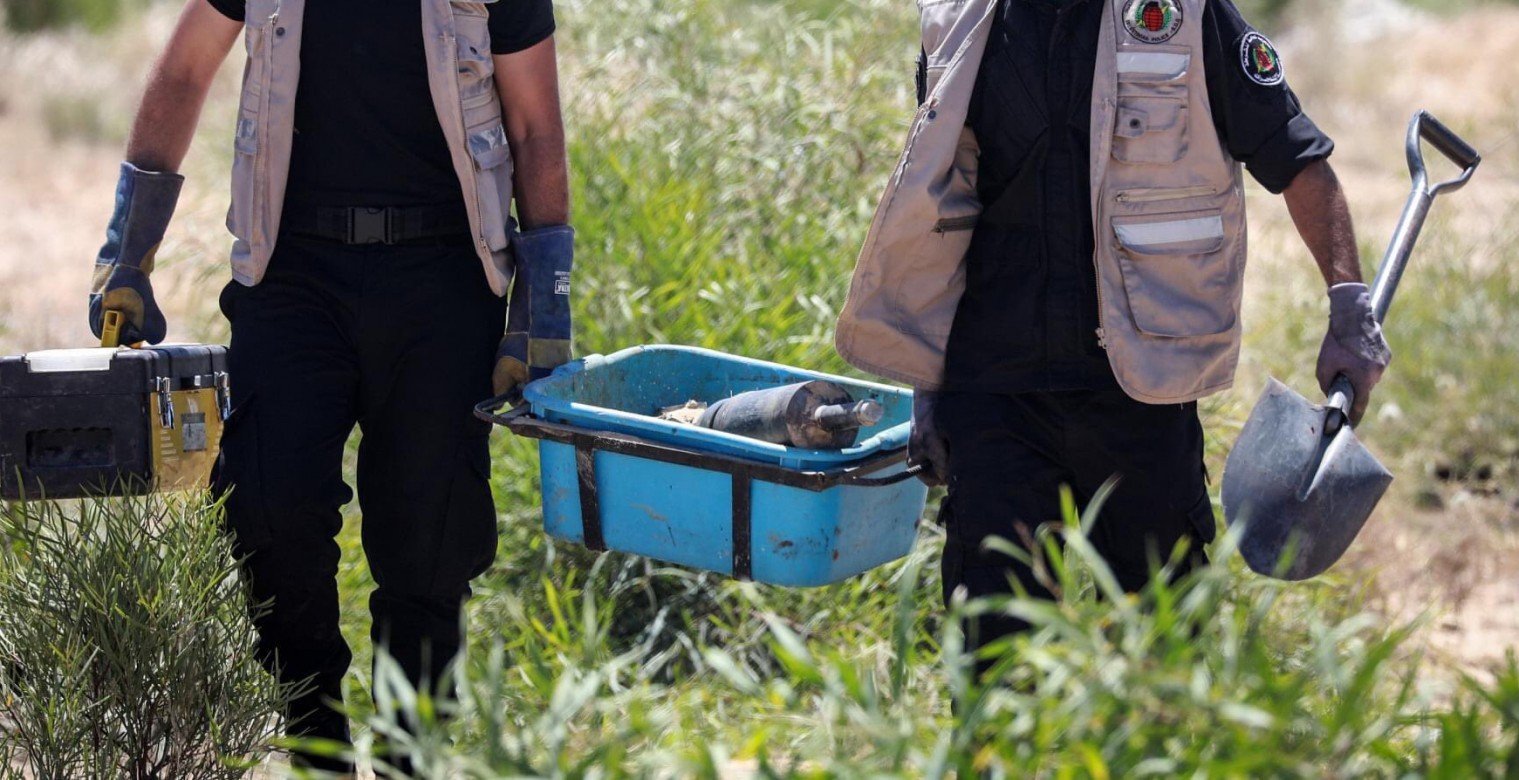Bombing news and Explosive remnants of war remaining are rarely shown in the daily press headlines as the political situation and high prices headlines are trending in today's front news. On the other hand, the ticking bombs in Gaza which no one can defuse should take media coverage due to threatening thousands of people lives.
Today as we approach nearly a year since the last Israeli aggression on the Gaza Strip on May 20, 2021, pedestrians are walking on Al-Wahda Street in the west of Gaza City - one of the liveliest streets in the city - without realizing the danger that threaten their lives, as there are 5 missiles At least. Meanwhile, the occupation remnants did not explode, they remained in the ground and have not been excavated until now, according to the testimony of the Explosives Engineering Department in the Gaza Strip Police.
Next morning of the aggression which lasted for 10 days, war has left the land with holes and life returned to be normal, people go back to their work and children to their schools without any warning signs in order to alert residents from the danger that threaten them especially since this street leads to “Dar Al-Shifa”, the largest government hospital in the city, in addition to a number of schools near the street.
There are no accurate statistics about the number of residents in the area where the missile remnants are located, but targeting this street extends for more than a kilometer and this may be clear in the map below:
The danger is not only on Al Wahda Street. There, for instance, in the Westren area of Beit Lahia, a farmer named Munther Abu Jarad expresses his fears about the possible casualties that may be if there were unexploded ordnance in the agricultural lands near his home.

Abu Jarad pointed out to "last story": during our daily routine while tilling the soil we are facing war's unexploded bombs. Moreover, the farmers don't deal with it with a sufficient awareness as they may hold it with their hands without being aware to the risks they may face" otherwise, others may while some people rush to contact the police as soon as they encounter these remnants, according to Abu Jarad.
In the northern of Gaza Strip, specifically on the thirteenth of August 2014, the Palestinian journalist Ali Abu Afash and his foreign colleague Camille Simon, along with four other civilians, and six wounded, have passed away while inspecting the process of dismantling an unexploded missile, carried out by explosives engineers.
During the qualitative research aiming at documenting the number of casualties as a result of explosive remnants of war and unexploded shells and missiles by Israel during its offensive on the blockaded Palestinian territory. More than 2,500 people were killed and injured as a result of these explosions, as it shown in the Arab countries reports by the landmine monitor during the period from .(1967-1998)
As Mr Mohamad Miqdad , the head of the Awareness and Guidance Department in Explosives Engineering in Gaza estimated the number of casualties during his administration period since its establish until now , about 20 victims.
Among Article 7 (Transparency Measures) on the Prohibition of the Use, Stockpiling, Production, and Transfer of Anti-Personnel Mines and on their Destruction states
we implemented the safety procedures but we didn't find the approximate number of unexploded rockets and missiles during the last aggression on Gaza in May 2021.However, regarding the preceded aggression on July 2014 which lasted for 50 days, It is reported that approximately 72,000 items of ordnance were fired and launched during this period, reported by the United Nations Mine Action Service (UNMAS).
According to the report, based on a 10% failure rate of these munitions, it is assumed that there are approximately 7,200 pieces of explosive remnants of war in Gaza. This is a reflection of the extent danger that facing the population at the time, till now.
Despite the huge amount of war remnants, there are no sufficient awareness about Providing risk education of these items. Mr. Meqdad justifies the absence of warning signs on Al-Wahda Street, by saying that "these various remnants, including missiles, bombs, and others, penetrated into the ground without exploding and settled 10-15 kilometers away, and it will not affect people's lives because they are stable and can only explode if excavations are carried out near them. "
In fact, no one guarantees that excavation works will occur on the road or the establishment of construction workshops in the area. Therefore, Miqdad's affirms that these shells don't threat people's lives or negate the suspicion that explosions may occur.
Miqdad indicates that field teams extract unexploded bombs on a daily basis, which is "American-made (M.K) family", adding that there is no specific number for the weights of rockets and gunpowder that have been extracted since the end of the aggression, until now.
However, he stressed that explosive engineering in the Gaza Strip destroys 400-500 kilos of remnants per week, indicating that they're currently working in Jabalia camp in the northern Gaza Strip, to remove the remnants of the recent Israeli aggression, which will be followed by excavations and excavations on Al-Wahda Street.
Meanwhile, he noted that the explosives engineering in the police force in Gaza works in cooperation with the United Nations Mine Service, although he said, "We work jointly to extract the remnants of the occupation, but UNMAS does not provide logistical support related to training our staff, on the pretext that the occupation prevents this.
Miqdad explains the reason for the delay in removing the waste to the lack of the necessary capabilities, the lack of necessary shields for the work teams, in addition to the lack of vehicles for transporting the waste after its extraction, and the need for waste excavation devices, "and Israel does not allow these materials to enter; this is what international bodies tell concerned when it is addressed,” he said.
Fears extends to reach the water not only land. As it's threatened the sea as Zakaria Bakr, head of the fishermen's committees in the Union of Agricultural Work Committees in Gaza, stated about the various shapes and sizes of remnants from unexploded bombs while practicing fishermen their work.
Bakr said, "We found strange items and containers in the fishing nets and since most of the fishermen do not have enough knowledge to deal with them, they throw them back into the sea." Regarding to what fishermen see, "the occupation's drones, which fly at low altitudes, throw various items into the sea that they are not aware of or even they didn't know how dangerous they are.
Beside these unlimited risks toward Palestinian fishermen as a result of unexploded mines, Baker expects to have a decline in fishing productivity due to bombs and wastes at sea.
The Israeli occupation forces continue to restrict fishermen since 2008 until now, whether by reducing the fishing area, or by shooting, assaulting and arresting them. As a result of the explosion which connected to a Quad-Capter helicopter that got stuck in their nets, 3 fishermen from the al-Lahham family were martyred, last year.
Director of the Palestinian Center for Human Rights, Raji Al-Sourani, stressed about the urgent need for laboratories to deal with these types of explosives and bombs, in addition to have a high awareness about dealing with them, as well as logistical support.



